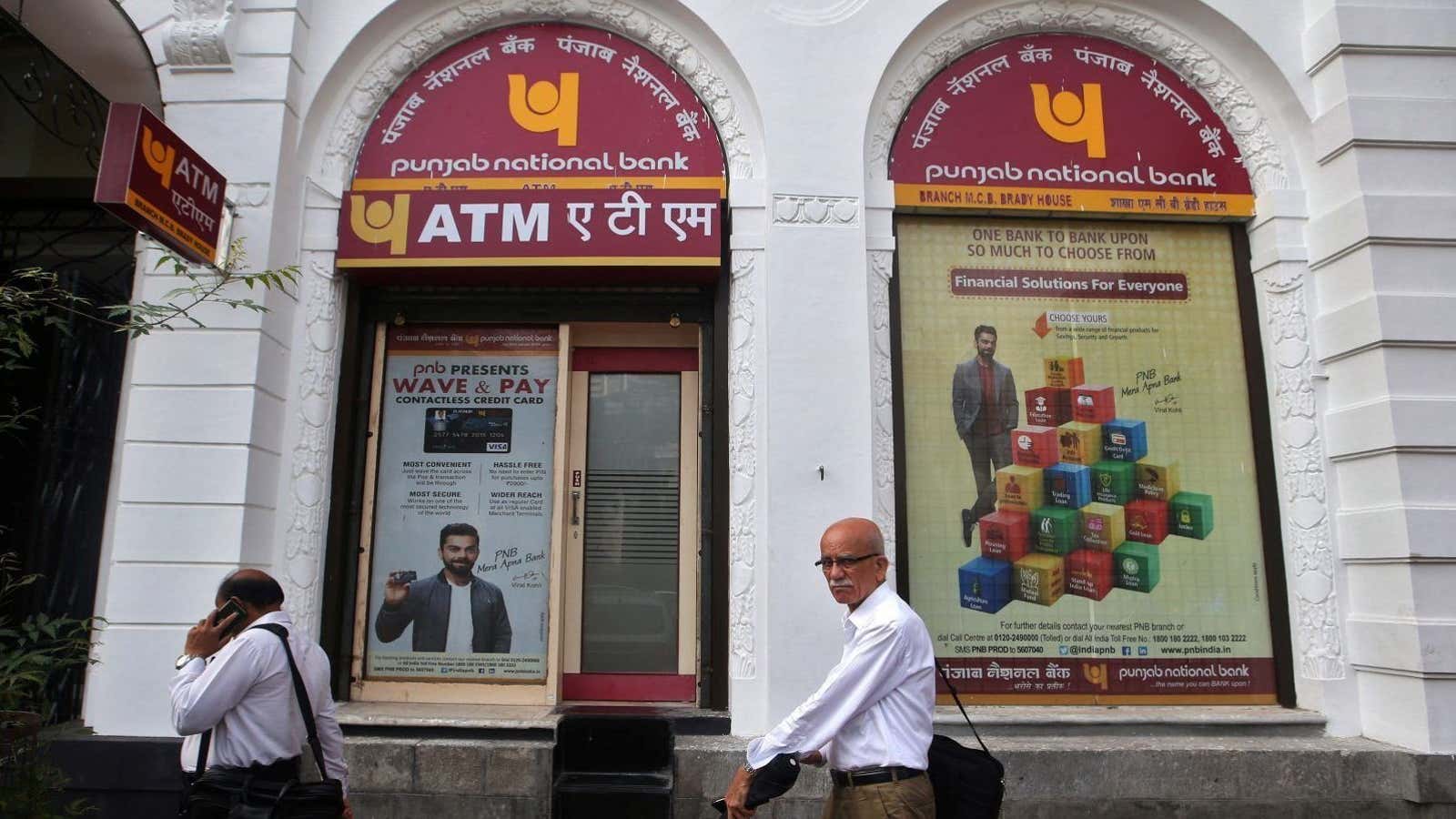Most officials and investors in India’s second-largest public sector bank didn’t see it coming. But on Feb. 14 last year, the day’s monotony was broken by a notice that went up on the stock exchanges in the morning.
The notice said Punjab National Bank (PNB) had been duped of $1.77 billion (or around Rs12,000 crore)—later revised to $2 billion, or over 50 times the bank’s net profit in the October-December 2017 quarter.
The revelation stirred a political storm and prime minister Narendra Modi’s government was accused of being soft on scamsters. The central bank’s accountability was questioned and there was a public spat between the government and the Reserve Bank of India (RBI). The country’s top investigative agencies soon stepped in and several top bank employees were charged with alleged involvement.
In the March quarter earnings, announced a month after the fraud was discovered, the bank reported the highest ever net loss by any Indian lender—Rs13,417 crore.
A year on, the New Delhi-based lender’s subsequent corrective measures have begun to reflect in its earnings. In the October-December 2018 period, PNB posted a surprise profit of Rs247 crore, after being in the red for three quarters on the trot.
However, equity markets haven’t been forgiving, yet: The bank’s market value as on Feb. 13, 2019 stood at Rs26,424 crore, a full 27% lower than on Feb. 14 last year.
The task of bringing the perpetrators to book is also far from complete. The alleged masterminds of the fraud, diamantaires Nirav Modi and his uncle Mehul Choksi, are still absconding. However, bank officials who colluded with the duo have been booked and some even suspended.
Here’s a look at what happened and how things have changed for PNB—and the Indian banking sector—since the monumental fraud came to light:
What exactly happened?
Over a period of seven years, a handful of PNB employees manipulated two key networks and instruments at the behest of Modi and Choksi to facilitate cross-border payments. These were SWIFT (Society for Worldwide Interbank Financial Telecommunications) and letters of undertaking (LoUs).
LoUs, or bank guarantees based on which overseas lenders grant loans, were issued by PNB via its SWIFT system in favour of Modi. It is believed that PNB employees shared the SWIFT password with Modi’s aide, which allowed them to conduct fraudulent transactions using the system.
Fraudsters typically use LoUs, which are generally recognised in the industry as a vulnerable tool. Manipulation of SWIFT is not unprecedented, either. Much before the PNB fraud was unearthed, the Reserve Bank of India (RBI) had raised red flags over the lack of adequate security protocols in SWIFT transfers. The central bank’s warning bells were allegedly ignored by Usha Ananthasubramanian, CEO of PNB between August 2015 and May 2017, when the fraud was in full swing.
In its charge sheet, the CBI held Ananthasubramanian accountable for this. At the time of filing the charge sheet, she was heading public lender Allahabad Bank, and was promptly sacked. The CBI also found 24 others, including some senior bank officials, guilty.
Modi and Choksi
The CBI had filed a case against the duo on Jan. 31, before the scam became public, and both were already on the run by then. Only sketchy details of their whereabouts have emerged since then.
Modi was initially suspected to be in Switzerland and then in the US. Later, he was reported to be seeking asylum in the UK. His lawyers told the courts about his inability to return to India for the fear of being lynched.
On the other hand, Choksi is now a citizen of Antigua and bringing him back to India will be difficult. In the Caribbean island, wealthy foreigners can become citizens in exchange for investments in the country. However, some officials still argue that he remains an Indian citizen though he has surrendered his Indian passport.
In the past year, Choksi, too, has made a few pleas expressing his inability to return to India. He cited health issues, fear of a media trial, and safety concerns, as his reasons.
India’s enforcement directorate has attached the duo’s properties across the country and raided their offices for recoveries.
The aftermath
PNB, on its part, has been trying to recoup its losses by hiring a detective agency and pursuing a legal course. But any substantial recovery of its dues seems unlikely for now.
And despite the profit clocked in the December quarter, it is not out of the woods yet.
“The bank’s operating performance has been much weaker relative to peers, denting our confidence…business momentum continued to be soft (albeit improving), which with sustained margin pressure restricting core operating profitability,” said an Edelweiss report released last week. The brokerage has a “reduce” rating on the stock.
Meanwhile, the gems and jewellery industry has had to face a severe backlash. Many firms complain that credit access has been severely restricted now.
Soon after the scandal broke out, the RBI discontinued LoUs. Now, whatever few alternatives to access bank credit were available have also turned expensive, say jewellers.
What’s changed?
The PNB scam jolted India’s banking industry out of its complacency. Another scam emerged in February 2018, this one involving Vikram Kothari, the owner of Rotomac Pens. Soon after, both the Indian government and the RBI pulled up lenders and laid down more stringent rules for lending, though many banks claim these were already being followed.
The jury is still out, though, on what has changed on the ground.
“Banks will be more cautious now and more responsibility will be placed on the auditors,” said Kalpesh Mehta, partner at auditing firm Deloitte Haskins & Sells. “However, one doesn’t know anything till things go wrong…(it) is nearly impossible to…say if we are better prepared or not because some technical lapses…are very difficult to avoid.”
The industry may be better off overall—but only till the next scam breaks out.
